At night in the wild, or when the power is out in the house, a good flashlight is not just a useful little thing, but a vital necessity. However, not all flashlights are the same, and with the knowledge of what distinguishes a decent device, one can turn a simple flashlight into a real life-saving instrument.
Here are the top features to look for in a quality flashlight. If you want a high-quality flashlight, check out Wuben Flashlight.
Top 7 Features A High-Quality Flashlight Must Possess
1- Robust Brightness
The intensity of a light is determined in lumens, and a flashlight of high quality should provide numerous lumens for different purposes. One hundred to three hundred lumens should be enough for simple tasks, but if you go camping or hiking, you might prefer to take a torch, ensuring one thousand lumens or even more to see more of the path.
2- Adjustable Settings
An effective flashlight should be adjustable, which means that one should be able to modify the force of light to save battery or make it brighter when necessary. Thus, particularly, it should have high, medium, and low. Additionally, it should strobe or emit SOS signal, because the latter are truly valuable.
3- Durability and Reliability
A good flashlight should be resistant to rough usage and environmental stress. You should make sure that the product has an IPX rating and is water-resistant or waterproof to some degree. Additionally, a flashlight made from a sturdy material, which is usually aircraft aluminum grade, will make the flashlight resistant to drops and impacts.
4- Battery Life
The most efficient flashlights provide long battery life without performance depreciation. Hence, the modern market offers a whole range of rechargeable flashlights that have become particularly popular since they save money and are ecologically friendly. High-end models usually possess such a useful feature as a power indicator that shows how full the battery is and, thus, helps to keep track of the usage and optimize it.
5- Portability and Size
An appropriate light must be easy to carry or store. It must be small enough to fit your pocket, glove box of your car or backpack. At the same time, its size should not make the flashlight any less functional – it should have an appropriate weight-size balance and a comfortable weight.
6- Beam Type and Distance
The type of beam that is possible with the lights in a flashlight, its size, and the distance over which it can be optimally maintained are dependent on the type of lens and reflector that is used. These are also some of the most highly variable components of flashlights, with wide beams and narrow beams, those that can be zoomed or focused into a point all being useful in their own right. A good flashlight should be able to comfortably light up an area of at least 100 m.
7- Versatility
A flashlight that provides versatility can be a good bonus point. A flashlight with a magnetic base, a belt clip, or that can be mounted on a weapon to be used in different ways can be a great option. Flashlight being a power bank and a device for multi-purpose use is excellent.
Conclusion
When the market is full of options, the quality of a flashlight wanders around its features. Brightness, durability, adjustable settings, beam type, battery life, user interface, size, and added versatility are the aspects you might wish to oversee. So, whether you are a camper, a homeowner, or a person who likes to be prepared, purchasing a good flashlight will allow you to treat darkness like your little helper.


